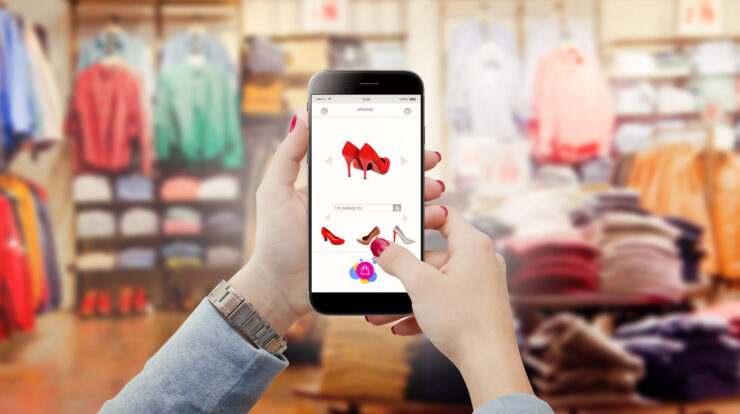
Digitization is changing many traditional industries, but today a real revolution could be taking place in the fashion business. The introduction of new technologies for body scanning, augmented reality and virtual fitting capabilities will lead to increased confidence in online shopping and an expansion in the share of online retail in the market. With virtual try on solutions, it is simpler for a customer to choose the appropriate garment size. This, in turn, helps the manufacturers to increase the average check and reduce clothing returns.
In 2020, we have witnessed technology advance at lightning speed as companies across all industries have undergone a significant digital transformation to survive and have embraced new technologies.
Among these technologies is augmented reality (AR). While many people may know AR because it prevails on social media like Snapchat, companies have already started to make the most of the popularity and engagement elements of AR filters in their marketing efforts.
Virtual fitting is a feature that uses AR technology to allow users to virtually try on items for size, fit, and style before purchasing them. For example, this technology was implemented in Gucci’s application. The Italian brand offered to try on sneakers from the new collection and then purchase them through the official website.
Perspectives of AR-based virtual try-on
AR technology also drives sales of fashion and beauty brands by enabling physical familiarity with a product before purchasing.
So far, such solutions are available mainly for trying on shoes and accessories: it is not an easy task to completely dress a person, because the position of the body in space is inconstant, which makes unstable and superimposed textures. But we expect these issues to be resolved soon, as AR evolves at an accelerated pace. This is facilitated, among other things, by the development of gadgets and platforms where this function is available: for example, Shopify made it easier for all brands to add AR content to this website.
According to Statista, the augmented reality market will reach $198 billion by 2025, up from $3.5 billion in 2017. Combined with 3D body scanning, AR technology unlocks innovations such as virtual fitting room technology, which 3D Insights predicts will reinvent the experience in retailing fashionable clothing.
Benefits of a virtual fitting room
A virtual fitting room has several benefits for the fashion business. By empowering customers to make more informed decisions when shopping online, virtual fitting technology is helping to gradually address many of the challenges facing the fashion industry today including fit, increased markdown, and environmental impact.
- Potential to increase revenues
The virtual try-on technology helps users to avoid mistakes when choosing clothes, which can lead to a possible increase in revenues for companies. According to Forbes Insights, virtual fitting can enable clothing manufacturers to offer more personalization options, which directly impacts sales and profits. The simple, unmistakable choice makes the decision easier. Even a customer who visits the site for the first time, after trying them on virtually, can buy several products.
- Fewer returns and exchanges
Using virtual fitting technology, customers can visualize themselves in a variety of styles and sizes before purchasing, helping to dramatically lower return rates, as they buy what they exactly like and need, and what would actually look good on them.
- Increased conversion
AR adoption has proven to be very effective as it accelerates purchasing decisions and contributes to the conversion rise through impulse purchases. According to Shopify, conversion rates increase by 250% when products are supported by virtual clothing try on technology.
- Increasing brand awareness
Since customers can share photos of them wearing virtual products with friends, family, and via social media, virtual fitting can also help build brand awareness and attract new customers. Virtual fittings are fun, so customers spend more time on the site. Moving from product to product, trying on more and more new products, they find things that they would not have paid attention to with a passing acquaintance with the site.
- Safety insurance
In a pandemic, trying on clothes online turned out to be a very convenient function, since it is completely safe. Consumers are spared from waiting in line to the dressing room. It also contributes to the development and establishment of the habit of buying clothes online, so in the long term, even after the pandemic, consumers will remain committed to this buying option.
Overall, we can say that in the fashion business, AR technology changes the approach to interaction with the client, reduces possible risks through a visual presentation of the product, and provides an opportunity to customize the product according to the needs, interests, and desires of the client.
Conclusion on AR virtual try on
One of the main disadvantages of buying clothes or shoes over the Internet is that the buyer cannot try on the item for its size and fit. Consumers cannot interact with the thing, compare whether the chosen color suits their skin or clothing. So the main idea is that augmented reality has the potential to transform e-commerce in new ways. By allowing consumers to try on things using AR technology, the fashion industry is breaking down the barriers between offline and online shopping.
AR has burst into the world of online shopping and has made great changes in it. For example, the number of returns will decrease due to the reason for buying the correct clothes size and fit. Users will be more active in trying new brands. AR technology is a wide field for experimentation, and ultimately these tricks can be not only entertainment but also a determining factor for a potential buyer. AR technology has the great potential to transform traditional and digital marketing practices.
By providing the ability to see and try out products online with the same genuine dressing room experience they would have had in store, AR technology for virtual fitting offers a new, vivid experience that increases efficiency for customers and raises profit for the business.


